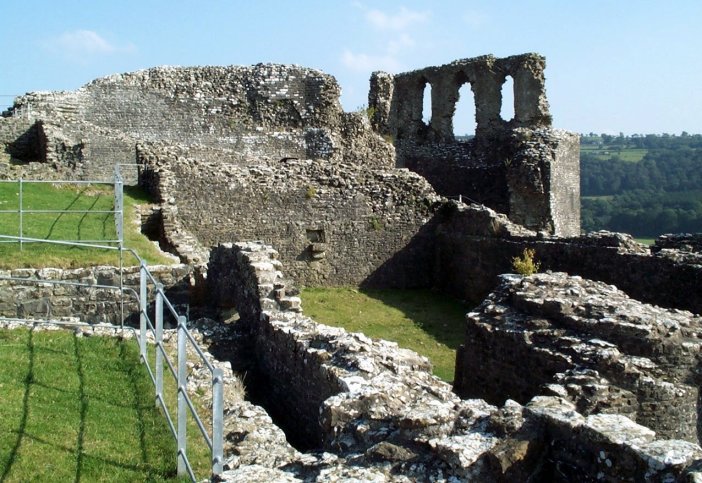Dryslwyn Castle

The castle crowns the summit of an isolated hill rising from the Afon
Tywi flood plain. The castle was initially founded by a
prince of
Deheubarth, possibly Rhys ap Gruffydd
(d.1197) or his son, Rhys Gryg
(d.1234), the latter certainly being lord of the district by
1227.
Maredudd ap Rhys inherited the castle on Rhys' death in 1234 and ruled
his lands from Dryswlyn castle until 27 July 1271 when he died within
the fortress, leaving the castle to his son, Rhys ap Maredudd
(d.1292). The castle endured its first known siege by royal
forces in 1245 and its history as a princely castle came to an end in
1287 when it was captured by the Crown after a desperate and famous
siege in which part of the wall was brought down burying the attackers
in a mine. The site of the siege mine is still plainly obvious in
the outer defences and not in the rock of the inner ward as is often
claimed.
There is a walled borough on the lower summit of
the
hill, which like the castle itself, was modified and repaired
throughout the fourteenth century, but no new building work seems to have been undertaken. In 1370, during a French
invasion scare, the castle contained a constable, Sir Rhys ap Gruffydd,
and 10 archers. Some 30 years later the castle was captured
in
1403 during the wars of Glyndwr. It remained in rebel hands
for
some 3 years before being abandoned and largely demolished.
Description
The earliest castle consisted of a strong, irregular limestone rubble
walled ward, about 120' east to west by the same deep,
which now mostly stands some 3' high. To the east, part of the
curtain wall was remodelled to make a garderobe with 2 shafts reached
up stone steps. At the north-east corner are the remains of the
original hole in the wall gateway. This was later expanded
eastwards to make it an internal gatehouse within which are the remains
of steps to the
wallwalk. These features survive only as foundations, but the lower jambs of the portcullis
slot remains within a cobbled passageway.
On the south side of the
gateway is the original round tower keep, 40' in diameter with walls 12' thick. It is set mostly within the
defences, just like the keep at Dinefwr. Dryslwyn keep was originally entered at first floor level from
external steps built above a broad north-west buttress. A ground
floor
doorway with segmental stone head, is a later insertion.
Within
the ward are the foundations of the early great hall with a later one
at right angles on its east side. The original hall has a
segmental-headed doorway in the north wall, with a narrow window to its
west. In the centre are the stone foundations of the hall fire
hearth and the outline of a small prison in the corner of the enceinte to the north.
A separate building phase consisted of a middle ward constructed on the
north-east side of the inner ward, again with a hole in the wall
gateway to the east. This ward did not contain all of the
original earthwork ward, with the re-entrant to the north-west
remaining as just an earthen rampart almost the same size as the castle
inner ward. At a later date another bailey was then added to
the north-east. The entire north-west front of the castle was
covered by a massive town ward.
Within the
original
inner ward, a new apartment block and chapel tower were added on the
south side,
directly overlooking the Tywi valley, probably at the same time as the
outer ward was built and the inner ward gatehouse constructed. The
projecting chapel on the east side was at first floor level and still
contains the remains of 3 lancet windows. This blocked a postern
gate in the original curtain wall at this
point. The 2 storey apartment block to the west of the chapel has
2 pointed windows in
the
lower storey and the jamb and embrasure of a third, while in the upper
storey a single similar opening survives with the jamb and embrasure of
a second opening. This wall and the north-west wall of the outer
ward are much thicker than the other walls. The outer ward
projecting rectangular gatetower is also of a peculair design, as
really is the whole castle. This suggests that the whole was built while the castle
was under Welsh control, ie. before 1288. With the substantial
settlement grown around the north side of the fortress Dryslwyn is the
largest known castle in Wales built by a Welsh lord.
Why
not join me at other Lost Welsh Castles next Spring?
Please see the information on tours at Scholarly
Sojourns.
Copyright©2017
Paul Martin Remfry

